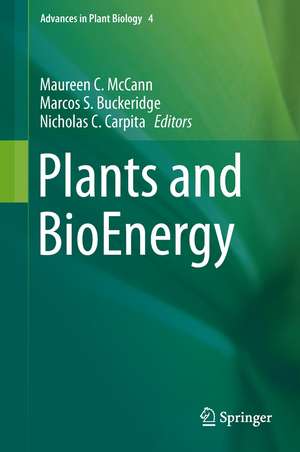Plants and BioEnergy: Advances in Plant Biology, cartea 4
Editat de Maureen C. McCann, Marcos S. Buckeridge, Nicholas C. Carpitaen Limba Engleză Hardback – 24 noi 2013
| Toate formatele și edițiile | Preț | Express |
|---|---|---|
| Paperback (1) | 944.67 lei 43-57 zile | |
| Springer – 23 aug 2016 | 944.67 lei 43-57 zile | |
| Hardback (1) | 947.35 lei 43-57 zile | |
| Springer – 24 noi 2013 | 947.35 lei 43-57 zile |
Preț: 947.35 lei
Preț vechi: 1155.30 lei
-18% Nou
Puncte Express: 1421
Preț estimativ în valută:
181.28€ • 189.75$ • 150.88£
181.28€ • 189.75$ • 150.88£
Carte tipărită la comandă
Livrare economică 31 martie-14 aprilie
Preluare comenzi: 021 569.72.76
Specificații
ISBN-13: 9781461493280
ISBN-10: 1461493285
Pagini: 300
Ilustrații: X, 289 p. 57 illus., 45 illus. in color.
Dimensiuni: 155 x 235 x 22 mm
Greutate: 0.5 kg
Ediția:2014
Editura: Springer
Colecția Springer
Seria Advances in Plant Biology
Locul publicării:New York, NY, United States
ISBN-10: 1461493285
Pagini: 300
Ilustrații: X, 289 p. 57 illus., 45 illus. in color.
Dimensiuni: 155 x 235 x 22 mm
Greutate: 0.5 kg
Ediția:2014
Editura: Springer
Colecția Springer
Seria Advances in Plant Biology
Locul publicării:New York, NY, United States
Public țintă
ResearchCuprins
Part I. Economics of Bioenergy.- Chapter 1. Advanced Biofuels: Economic Uncertainties, Policy Options, and Land Use Impacts.- Chapter 2. The prospects of first generation ethanol in developing countries.- Chapter 3. Can energy policy drive sustainable land use? Lessons from Biofuels Policy Development over the Last Decade.- Chapter 4. Algae Farming and its Bio-products.- Part II. Biomass Biology.- Chapter 5. Regional gene pools for restoration, conservation, and genetic improvement of prairie grasses.- Chapter 6. Mining Genetic Diversity of Sorghum as a Bioenergy Feedstock.- Chapter 7. Genetics, genomics and crop modelling: integrative approaches to the improvement of biomass willows.- Chapter 8: Xylan biosynthesis in plants, simply complex.- Chapter 9. Towards redesigning cellulose biosynthesis for improved bioenergy feedstocks.- Chapter 10. Camelina: An Emerging Oilseed Platform for Advanced Biofuels and Bio-Based Materials.- Part III. Biomass Processing.- Chapter 11. Developing novel enzyme repertoires for the efficient deconstruction of plant biomass tailored for the bioenergy industry.- Chapter 12. Using Natural Plant Cell Wall Degradation Mechanisms to Improve Second Generation Bioethanol.- Chapter 13. Lignocellulosic Biorefineries: Concepts and Possibilities.- Chapter 14. Linking Plant Biology and Pretreatment – Understanding the Structure and Organization of the Plant Cell Wall and Interactions with Cellulosic Biofuel Production.- Chapter 15. Catalytic oxidation of lignin for the production of low molecular weight aromatics.- Chapter 16. Catalytic dehydration of lignocellulosic derived xylose to furfural.- Chapter 17. Perspectives in Brazil of the contribution of palm trees to biodiesel production.
Caracteristici
Endorsed by the American Society of Plant Biologists Worldwide coverage of issues regarding plants and bioenergy Comprehensive and up-to-date



















